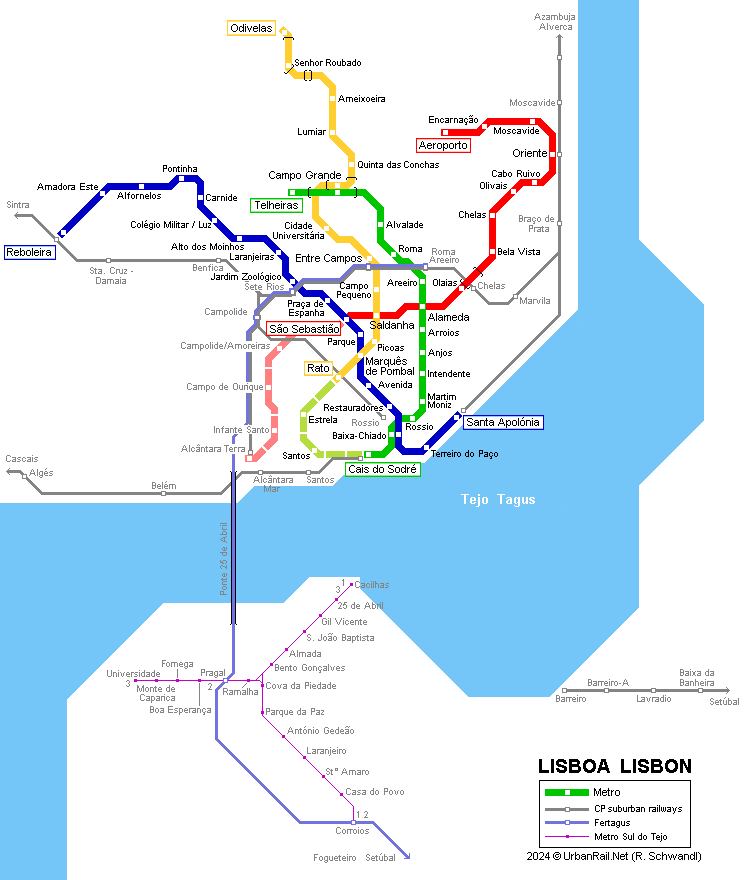
|
[ UrbanRail.Net ] [ Europe ] [ Americas ] [ Asia ] [ Africa ] [ Oceania ] [ News ] [ Books ] [ Links ] |
| Portugal |

| METRO | ||
|
Linha
da Gaivota
(Seagull line): Colégio Militar/Luz - Campo Grande
via Alameda Metro Lisboa decorates all stations with some artistic elements (see official page below) which is especially visible on the new Oriente Line (mainly interesting Olaias, Chelas and Oriente stations). Older stations are of a very simple design with small wall decorations.
|
||
| Linha Azul | ||
|
More
about In March 1998 some station names changed: Sete Rios > Jardim Zoológico, Palhavã > Praça de Espanha, Rotunda > Marquês de Pombal |
||
| Linha Verde | ||
|
More
about In March 1998 Socorro station was renamed into Martim Moniz. |
||
| Linha Amarela | ||
|
More
about
|
||
| Linha Vermelha | ||
|
More
about
|
||
| Photos | ||
|
1999 © Robert Schwandl |
||
| History | ||
|
Click here for detailed Lisbon metro history (thanks to Alex Riabov).
|
||
|
Other Rail Transit in Greater Lisbon |
||
|
Caminhos de Ferro Portugueses (Portuguese Railways) operates a suburban service on 3 main routes: Linha
de Sintra (from Lisboa-Rossio via Benfica to Sintra; Oriente - Mira
Sintra/Meleças; Alverca - Oriente - Sintra weekday peak times) More
about Since July 1999, a new rail link across the Ponte 25 de Abril (Tagus bridge) has been operated by FERTAGUS between Roma-Areeiro and Fogueteiro on the south bank with trains every 10-20 minutes. On 6 October 2004, Fertagus extended the suburban railway service from Fogueteiro to Setúbal (hourly). More
about Unfortunately adjacent metro and rail stations do not always have the same name: CP
station Rossio is served by Metro Restauradores (not Rossio) Eléctricos (Trams) Lisbon is famous for its old-style tram lines that serve the hilly neighborhoods of Alfama and Chiado (lines 12 and 28) but only a few lines of the once large tram network are left over. Line 15 to Belém is served by modern low floor trams. A new transportation system opened on 7 June 2004 in the municipality of Oeiras, west of Lisbon. The system called SATU (for Sistema Automático de Transportes Urbanos de Oeiras) was similar to a monorail but with wheels. It started from Paço de Arcos station on the CP Cascais suburban line. It used to have 3 stations (Navegantes - at the CP station, Tapada and Fórum) and was once planned to be extended to Lagoas Park and Tagus Park. However, service was discontinued on 31 May 2015. Metro do Sul do Tejo On the south shore of the Tagus River, a light rail network operating mostly on separate right-of-way was built. The first section from Corroios to Cova da Piedade opened on 30 April 2007. The western branch from Cova da Piedade to Universidade was brought into service on 15 Dec 2007, and the system was completed on 27 Nov 2008 with the opening of the Cacilhas leg through the Almada town centre. More
about |
||
| Projects | ||
|
In April 2021, construction started on a link between Rato and Cais do Sodré for the creation of a Linha Circular (Circle Line) which will eventually leave a Yellow Line shuttle between Telheiras and Odivelas. Later, the Red Line will be extended from São Sebastião to Alcântara Terra via Campolide/Amoreiras and Campo de Ourique. A northern branch from Moscavide to Sacavém is also planned. The Green (Yellow) Line may be extended from Telheiras to Pontinha (3 km). View map with proposed extensions! |
||
| Links | ||
|
METROPOLITANO DE LISBOA (Official page) Carris (Tram and Bus Operator) CP - Rail services in the Greater Lisbon area Fertagus (Cross-Tagus Rail Link) Metro do Sul do Tejo (Light rail on south bank of Tagus River) Transporlis - Transport info Portal VIVA (Smartcard system) Other websites: Metropolitano de Lisboa at Wikipedia.pt Scanned map from my collection - (planned network for 2000 on city map) (170K) |
||
| Film | ||
|
"How to use the Metro" - original 10-minute film from 1959! |
||
| Photos | ||




All pictures © Robert Schwandl, except (5) © Igor Dudchenko
Thanks to Alvaro Dias & Carlos Godinho for the information!
2004 © UrbanRail.Net by Robert Schwandl.